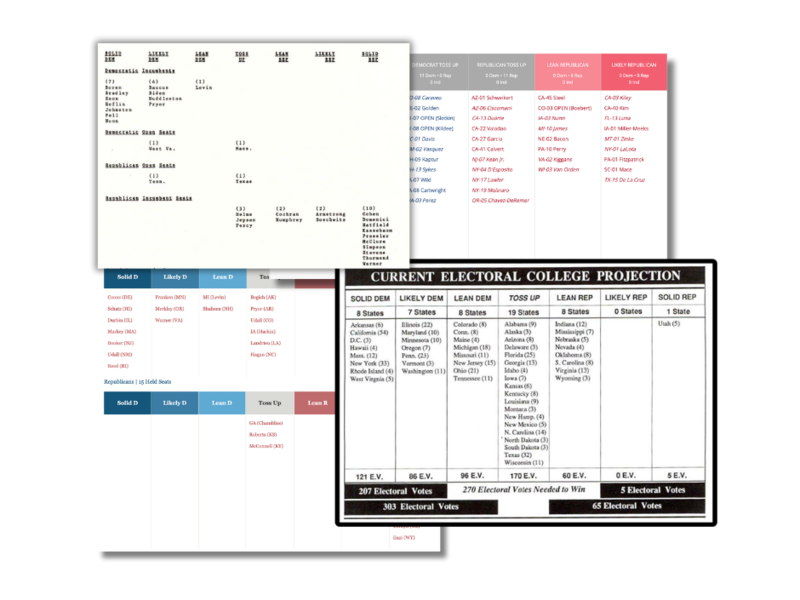
Unless the saber rattling between President Trump and Iran gets much louder in the coming days, the political talk next week will be about the first pair of Democratic presidential debates Wednesday and Thursday nights. But there was plenty going on this week, starting off with Trump kicking off his reelection campaign with a rally in Orlando, Florida. While in his almost 76-minute long speech the president ticked off a long and familiar list of grievances against Joe Biden, Hillary Clinton, Robert Mueller, Bernie Sanders, the “fake-news media” and “depraved” Democrats, a new element in his messaging this week was a change in the immigration fight from building the wall to deporting illegal aliens. In a tweet, he said, “Next week ICE will begin the process of removing the millions of illegal aliens who have illicitly found their way into the United States,” referencing the U.S. Immigration and Customs Enforcement agency. He continued: “They will be removed as fast as they come in.”
This seemed to be a surprise to ICE officials. Yet from Trump’s standpoint, shifting the focus of the fight from the wall, which is clearly not happening, to a more realistic policy of deportations, makes sense from now through the election. As columnist Ron Brownstein and others have noted, many in Trump’s base fervently believe that the country is changing too much and too fast, that too many immigrants have come to this country over the past few decades and that is changing the country’s character, values, and trajectory. Shifting the immigration focus to slightly different terrain keeps his base stirred up, shifting the fight from a course of action that has largely failed to one that can still be pursued. Keeping the pot stirred seems to be his course of action, although constantly changing the subject is also a favorite.
That said, the shift doesn’t seem to make sense, at least to me, in terms of reaching out to that quintile in the middle of 2.5 or 3 points to win (he lost by 2.1 points in 2016). To get there, he’ll need to win between two-thirds and three-quarters of that 20 percent in the middle. The percentages strongly approving of the job he’s doing were 28 and 29 percent in the May and June Fox News polls, respectively, with 44 and 41 percent strongly disapproving in the two polls. In both the late April/early May and the June NBC News/Wall Street Journal polls, the strong approve was 29 percent, while the strong disapprovals were 41 and 44 percent, respectively.
The Fox poll showed Trump with between 39 and 41 percent of the vote against Joe Biden, Pete Buttigieg, Kamala Harris, Bernie Sanders, and Elizabeth Warren, with the Democrat in each case getting between a low of 41 percent (Buttigieg) and a high of 49 percent (Biden).
Taking into account the strong first-quarter economic growth, and the lowest unemployment rates in 49 years in April and May, those numbers have to be deeply troubling for Republicans. His numbers seem impervious to favorable economic news; his approval ratings just don’t fluctuate much with new developments, positive or negative. But consider what those leaked internal polls from March showed, compared to how each state voted in 2016:
- In Georgia, a state that Trump won by 5 points, Biden is up by 6 points, an 11-point swing.
- In Iowa, a state Trump won by 9, Biden was up by 7 points, a swing of 16 points.
- In Maine, where Hillary Clinton won by 3 points, Biden is ahead by 15 points, a 12-point swing.
- In Michigan, where Trump won by just two-tenths of a point, Biden was ahead by 13 points, a 13-point swing.
- In Minnesota, Clinton won by 2 points, but Biden was ahead by 14 points, a 12-point swing.
- In North Carolina, a state Trump won by 4 points, Biden led by 8 points, a swing of 12 points.
- In Ohio, Trump won by 8 points, but Biden was up by a point, a 9-point swing.
- Texas, where Trump won by 9 points, shows him up by just 2 points, a 7-point swing.
- Virginia, a state where Clinton won by 5 points, has Biden up by a whopping 17 points, a 12-point swing.
In these nine states, the average swing was 12 points. Specific margins in Florida, Pennsylvania, and Wisconsin apparently haven’t leaked out, but are between 10 and 13 points each, consistent with the average. Keeping in mind that his job-approval rating has barely budged nationally since then, even if the 2016 to 2020 swing is a half or a third what his campaign’s polls reportedly show, that is coming up way short. Keep in mind that the swing in the 2018 midterm-election vote compared to the 2016 presidential was about 6 points. Again, this is not at all to say that Trump can’t or won’t get reelected—and it certainly matters who the Democratic nominee is—but the 54 percent of Americans and the 57 percent of 700 institutional investors recently surveyed who expect that he will be reelected might want to shift back to even-money, at least
This story was originally published on nationaljournal.com on June 20, 2019









Subscribe Today
Our subscribers have first access to individual race pages for each House, Senate and Governors race, which will include race ratings (each race is rated on a seven-point scale) and a narrative analysis pertaining to that race.